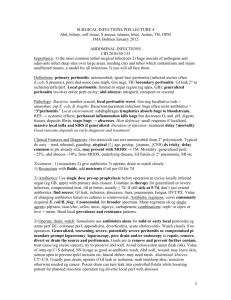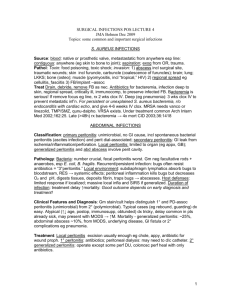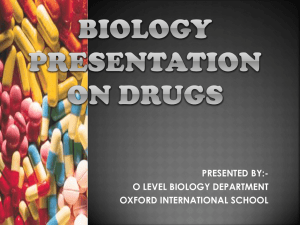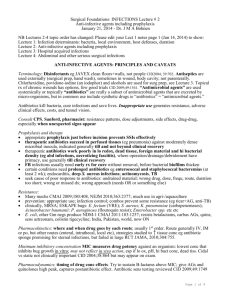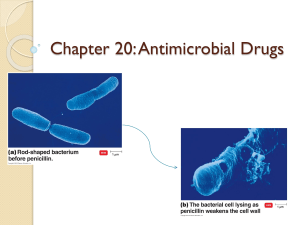Surgical Infection IV
advertisement
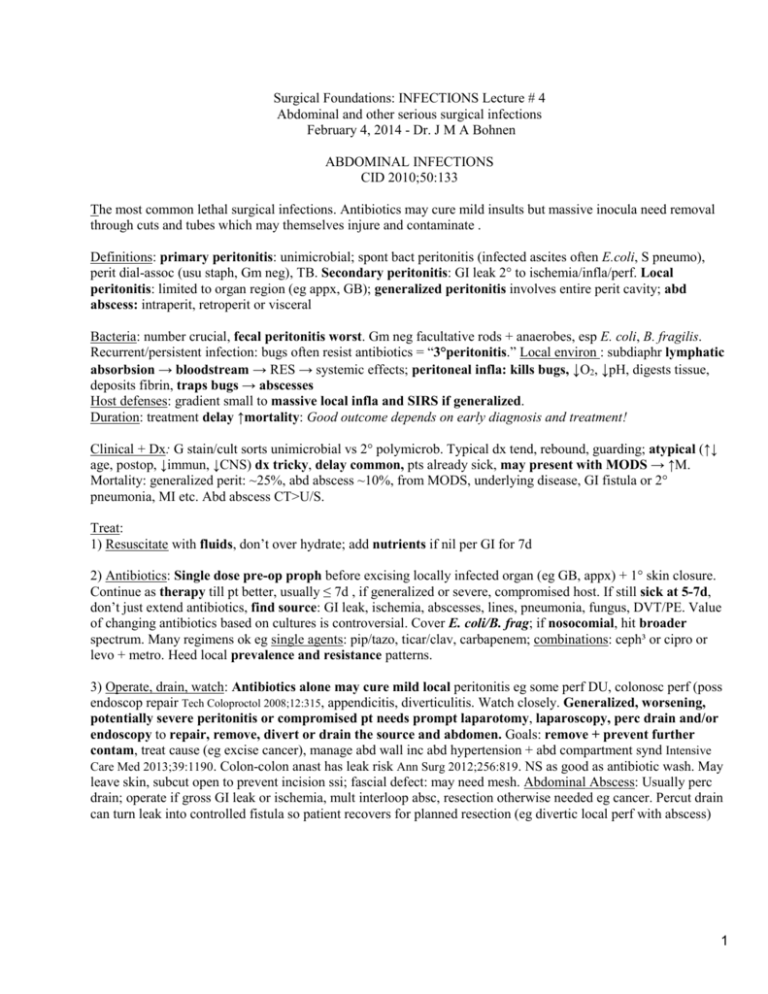
Surgical Foundations: INFECTIONS Lecture # 4 Abdominal and other serious surgical infections February 4, 2014 - Dr. J M A Bohnen ABDOMINAL INFECTIONS CID 2010;50:133 The most common lethal surgical infections. Antibiotics may cure mild insults but massive inocula need removal through cuts and tubes which may themselves injure and contaminate . Definitions: primary peritonitis: unimicrobial; spont bact peritonitis (infected ascites often E.coli, S pneumo), perit dial-assoc (usu staph, Gm neg), TB. Secondary peritonitis: GI leak 2° to ischemia/infla/perf. Local peritonitis: limited to organ region (eg appx, GB); generalized peritonitis involves entire perit cavity; abd abscess: intraperit, retroperit or visceral Bacteria: number crucial, fecal peritonitis worst. Gm neg facultative rods + anaerobes, esp E. coli, B. fragilis. Recurrent/persistent infection: bugs often resist antibiotics = “3°peritonitis.” Local environ : subdiaphr lymphatic absorbsion → bloodstream → RES → systemic effects; peritoneal infla: kills bugs, ↓O2, ↓pH, digests tissue, deposits fibrin, traps bugs → abscesses Host defenses: gradient small to massive local infla and SIRS if generalized. Duration: treatment delay ↑mortality: Good outcome depends on early diagnosis and treatment! Clinical + Dx: G stain/cult sorts unimicrobial vs 2° polymicrob. Typical dx tend, rebound, guarding; atypical (↑↓ age, postop, ↓immun, ↓CNS) dx tricky, delay common, pts already sick, may present with MODS → ↑M. Mortality: generalized perit: ~25%, abd abscess ~10%, from MODS, underlying disease, GI fistula or 2° pneumonia, MI etc. Abd abscess CT>U/S. Treat: 1) Resuscitate with fluids, don’t over hydrate; add nutrients if nil per GI for 7d 2) Antibiotics: Single dose pre-op proph before excising locally infected organ (eg GB, appx) + 1° skin closure. Continue as therapy till pt better, usually ≤ 7d , if generalized or severe, compromised host. If still sick at 5-7d, don’t just extend antibiotics, find source: GI leak, ischemia, abscesses, lines, pneumonia, fungus, DVT/PE. Value of changing antibiotics based on cultures is controversial. Cover E. coli/B. frag; if nosocomial, hit broader spectrum. Many regimens ok eg single agents: pip/tazo, ticar/clav, carbapenem; combinations: ceph³ or cipro or levo + metro. Heed local prevalence and resistance patterns. 3) Operate, drain, watch: Antibiotics alone may cure mild local peritonitis eg some perf DU, colonosc perf (poss endoscop repair Tech Coloproctol 2008;12:315, appendicitis, diverticulitis. Watch closely. Generalized, worsening, potentially severe peritonitis or compromised pt needs prompt laparotomy, laparoscopy, perc drain and/or endoscopy to repair, remove, divert or drain the source and abdomen. Goals: remove + prevent further contam, treat cause (eg excise cancer), manage abd wall inc abd hypertension + abd compartment synd Intensive Care Med 2013;39:1190. Colon-colon anast has leak risk Ann Surg 2012;256:819. NS as good as antibiotic wash. May leave skin, subcut open to prevent incision ssi; fascial defect: may need mesh. Abdominal Abscess: Usually perc drain; operate if gross GI leak or ischemia, mult interloop absc, resection otherwise needed eg cancer. Percut drain can turn leak into controlled fistula so patient recovers for planned resection (eg divertic local perf with abscess) 1 BILIARY TRACT INFECTIONS (Usually stones, less often tumor; parasites) Bacteria: enteric (E. coli, Klebsiella…), strept, enterococci. Anaerobes unusual, clostridia in diabetics (incl emphysematous cholecystitis); anaerobes in suppurative cholangitis, elderly Acute cholecystitis: calculous: cystic duct obstr’n; bactibilia; antibiotics little help for GB but prevent ssi; acalculous (uncomm, sick, NPO). Rx: Cholecystectomy, perc cholecystostomy if too sick Acute cholangitis without suppuration: Charcot’s triad (abdominal pain, jaundice, fever/chills). CBD stone usually. Not immediately life threatening, but mandates biliary decompression within hours. Acute suppurative cholangitis (dying): Charcot’s triad: PLUS hypotension, confusion = Reynolds’s pentad. Needs immed CBD decompression (ERCP or OR). Pip-tazo, amp-sulbactam, carbapenem; Ceph³/4 or quin plus antianerobe if old, sick, cholangitis SHOCK AND ORGAN FAILURE FROM INFECTION NEJM 2013;369:840 Terminol: Severe injury, infla (pancreatitis, burn) or infection → systemic inflammatory response syndrome (SIRS) = fever, ↑HR, ↑RR, ↑WBC. Sustained SIRS → multi organ dysfunc syndrome/ failure (MODS/MOF). “Sepsis” is SIRS 2° to infection. Septic shock is sepsis with hemodynam failure, ↓ tissue perfusion, usually bacteremia. Septic shock: heart: supravent dysrhyth, contractility; cardiovasc effects: hyperdynamic ( PVR CO, “warm shock “) or hypodynamic ( PVR CO, “cool shock “). Cool shock, like hemorrhagic, probably common end– stage, tissue O2 supply/demand mismatch. MODS is less acute, may indicate serious occult infection. Each system has characteristic signs: CNS: confusion, LOC; CV: shock, dysrhyth; RESP: ARDS; GI: bleed, ileus; HEPAT: jaundice, LFT; GU: ARF; BIL: acalculous cholecystitis; METAB: hyperglycemia esp if TPN; HEMAT: DIC, pmn, anemia, MSS: weakness, vent capacity. # failed organs mortality: 1:30%, 2:60%, 3:85%, 4: 80-99% (dep on duration) Causes of SS/SIRS/MODS: abd infection, pneumonia, vascular catheters, burns most common. Pathophysiology, therapeutic targets: Multifactorial. Bacterial products → 2° factors (inc fluid admin, barotrauma, O2 tox) → ARDS, renal failure, MODS. Cytokines key but anti-cytokines eg anti-TNF not useful. Coag activ via cytokines, endothelium and monocytes. End product thrombin makes clot, inhibits removal locally and systemically, makes fibrin split products including D-dimers via fibrinolysis. Generalized coag depletes anticoag protein C + other anticoags and has positive feedback loop with inflam cascades – coag and infla run amok. Modulating infla/coag with protein C promising, expensive, ↑bleeding, then found useless NEJM 2012;366;2055, 2122. Treat SS, SIRS and MODS: 1) find infection 2) cure infection: excise, divert, drain, debride, clean to control source CanJSurg1999;42:122; antibiotics: target bugs (if wrong ↑M Lancet 2004;363:1721) or broad spectrum; give asap, 8% ↓survival per hr delay after hypotension Crit Care Med 2006;34:1589 3) support homeostasis: fluids, inotropes, goal directed therapy/ insulin NEJM 2001;345:1368,1359 but not intense insulin NEJM 2008:358:125; nourish. Steroids only if no response to fluids, inotropes CCM 2008;36:296, don’t work even if adrenal insuff NEJM 2008;358:111,188. Px: 20-30% die; physical, psych sequelae in survivors, ↓QOL, ↑costs ↑health care use after ARDS NEJM 2011;364:14 2 SOME POINTS ABOUT ABSCESSES S. aureus causes abscesses anywhere. Antibiotics penetrate abscesses, but may be inactivated. Treat most abscesses with drainage/excision and antibiotics. Antibiotics may succeed without drainage in well perfused environment including brain, lung, liver (if small, multiple), tubo–ovarian. Amebic liver abscess cured with oral metronidazole. SPREADING SOFT TISSUE INFECTIONS SSTI CID 2007;44:705 Confusing names eg anaerobic cellulitis, nonclostridial crepitant cellulitis, necrotizing fasciitis, streptococcal hemolytic gangrene describe similar syndromes. Avoid confusion The names refer to 5 things: level, necrosis, bugs, gas, bact synergy. Only level and necrosis matter clinically: At risk: Diabetes, trauma, obesity, unresolved contiguous infection, abdominal operation, vascular insufficiency, perianal/rectal abscess: esp if blood supply Pathology and other features of descriptors in the names of syndromes LEVEL cellulitis: subcut tissue; erysipelas: dermis, distinct border fasciitis myositis or myonecrosis: muscle NECROSIS (“necrotizing;” “gangrene” = ischemic necrosis) level + presence of necrosis determine treatment BACTERIA: Polymicrob fecal eg Gm neg enteric, anaerobes; or unimicrob esp Grp A strep, clostridia, S. aureus. CREPITUS: gas in tissue on exam means anaerobes or facultative aerobes SYNERGY: eg Meleney’s progressive synergistic gangrene S. aureus + microaerophilic strep Authors use many combinations of those descriptors, hence the confusion; but dx + rx do not require knowledge of those names or combinations. You must determine level and whether necrosis is present: Diagnosis of SSTI All viable Type 1 Cellul/erysip Fasciitis Myositis Necrosis Cellulitis/erysip Fasciitis Type 2 Myonecrosis Type 1 (=viable cellulitis): use antibiotics Type 2 (deep or dead): use antibiotics + operate Clinical dx guides key decision (operate or not). Determine level and if necrosis present to distinguish simple cellulitis or erysipelas (type 1) from necrotizing cellulitis, fasciitis, or myonecrosis (type 2). Treat type 1 with antibiotics only, operate + antibiotics for “deep or dead.” Missed type 2 SSTI → loss of life, limb. Local findings of type 2: discolouration other than pink (blue, brown, black, crimson); excruciating pain, tenderness, hypesthesia, anesthesia, paresis, paralysis; discharge; putridity; extreme swelling, woody induration. Crepitus may occur in type 1 but suggests type 2. Advancing erythema despite adequate antibiotics suggests type 2. Mark borders with waterproof marker, followed closely over minutes then hours. 3 Systemic findings of type 2: confusion, lethargy, renal insufficiency possibly with myoglobinuria, shock, hypoxemia, DIC. If suspect more than simple cellulitis, get XRs for FB, gas, osteomyelitis. Hi fever may occur with type 1 or 2. If in doubt, explore under local anaesthesia, look for fascia involvement (probe slides without resistance), dead fascia or muscle (°contraction, °bleeding, stink). Micro dx: gm stain, culture of infected tissue may influence antibiotic rx and epidemiology, especially if unimicrobial. Type 1 usually unimicrobial, often strep, staph, other Gm pos, Gm neg; anaerobes in ischemic tissue, resistant bugs in hosp setting. Erysipelas + lymph obstr usually strep. Type 2 uni- or poly-microbial. Culture may allow narrower antibiotic spectrum. Aspiration of injected saline: 20% yield. Antibiotics for type 1 cellulitis and erysipelas: clox, pen+clox, cefaz, amox/clav, clinda, clarithro etc + close observ NEJM 2004;350:904. If not improving in 24h add Gm neg, anaerobe coverage, consider explore for Type 2. Treat type 2 infections the same regardless of microbial etiology or tissue level: debride aggressively, amputate if nec. (Exception: TSS below). Resusc with O2, fluids. Usually spare sphincters in perineal SSTI (“Fournier’s gangrene”) and testicles and because of independent blood supply, unless internal spermatic artery thrombosed. Antibiotics for type 2: Unless unimicrobial (eg strep or clostrid), cover Gm pos cocci, Gm neg rods and anerobes eg pen+quin+clinda, imipenem/meropenem/ertapenem. Hyperbaric O2 WJS 2011;35:535 recommended for clostridial myonecrosis, limited to centres (eg TGH) where available; efficacy unproven, but strong theoretical + anecdotal support. DON’T DELAY OPERATION FOR HYPERBARIC O2. Hyperbaric O2 may help resid infection if cannot excise eg head + neck or pt refuses amput Three common clinical syndromes: 1) Clostridical myonecrosis = “gas gangrene” Microbiology: C. perfringens, other clostridia; at risk: 1) trauma 2) abdominal surgery 3) spontaneous – diabetes, vascular insufficiency, perirectal abscess: esp if blood supply; bact toxins, hemolysins Clinical: Severe pain, crepitus usually, sepsis; shock, acute renal failure assoc with muscle necrosis 2) Necrotizing fasciitis + necrotizing cellulitis Microbiology: Unimicrobial (less common): strep, clostridia, gm negs, others. Usually polymicrob enteric + gm neg anaerobes ie GI flora; at risk: diabetes, obesity Clinical: Most common type 2 infection; skin discolouration, blisters, “dishwater pus” 3) Meleney’s gangrene = “progressive synergistic gangrene” uncommon except in books, exams Microbiology: microaerophilic nonhemolytic strep + S. aureus Clinical: Tender circle: black centre, purple, red on outside. tracts burrow. Rx: antibiotics +/- wide excision TOXIC SHOCK SYNDROME (TSS) Micro/clinical: Toxin-mediated shock, MODS, S. pyogenes S. aureus infection commonest, palmar/plantar erythroderma, desquam assoc with S. aureus. Origin vagina (S. aureus, tampons), surgical wound (esp S. aureus), SSTI (esp S. pyogenes) or obscure. Mortality ~15%. Rx: hi dose clox or pen plus clinda ( toxin prod). Add IVIG, esp for strep; IVIG neutralizes superantigen, trends to ↓ mortality CID 2003;37:333, 2010;51:58 used in Toronto, controversial. Invasive S. pyogenes eg nec fasciitis + 4 TSS: routine screening+proph of household contacts not indicated, but consider for hi risk (chickenpox, HIV, diab, cancer, hrt dis, IV drugs, steroids: CID 2002;35:950). MSH has expertise and database. S. AUREUS INFECTIONS Source: blood: native or prosth valve, metastastatic from anywhere esp line; contiguous: anywhere (eg skin to bone to joint); aspiration; airborne/fomite eg OR, trauma. Community MRSA incidence continually ↑ Path: Toxin: food poisoning, TSS 1) Local invasion: abscess incl surgical site, traumatic wounds; skin incl furuncle, carbuncle (coalesced furuncles); brain; lung; LKKS; bone (osteo); muscle (pyomyositis, incl “tropical,” HIV) 2) regional spread eg cellulitis, fasciitis 3) metastatic 4) FB/implant-assoc Dx: Get cardiac echo for persist/unexplained S. aureus bacteremia esp if intra-cardiac device CID 2011;53:1. Treat: Drain, debride, remove FB as nec. Antibiotics for bacteremia, infection below skin, regional spread, sick, immunocomp, to preserve infected FB. Bacteremia is serious - if remove focus eg line, rx 2 wks clox IV. Deep (eg pneumonia): 3 wks clox IV to prevent metastatic inf’n. For persistent S. aureus bacteremia, get cardiac echo, give 4-6 wks IV clox. Cephs may be as good as clox; ceftriaxone only once/d CID 2012;54:585. MRSA needs vanco, clinda, linezolid, TMP/SMZ, or doxy CID 2011;52:285; maybe rifampin; linezolid may be better than vanco CID 2012;54:621.VRSA: daptomycin better if vanco MIC is high CID 2012;54:51; Under-treatment is common Arch Intern Med 2002;162:25. Late (>48h) rx of bacteremia → 4x mort CID 2003;36:1418. TETANUS Bull ACS 1996;81:42 Micro/at risk: Clostridium tetani. LACK OF PREVIOUS IMMUNIZATION! Trauma, severe contam esp fecal, dead tissue, ↓blood supply (it’s an anaerobe), heroin addict, bite, neonatal oomphalitis Pathogenesis: C. tetani spores become vegetative in local anoxia tetanospasmin (neurotoxin) travels in blood, along axons (days to weeks, dep how close to CNS) inhibits inhibitory neurotransmitters spasm, irritability. Clinical forms: Local: mild, but may become generalized. Cephalic: rare, head injury a cause, involves VII n, may become generalized Generalized – 80% of cases. Local tingling then muscle rigidity, T 2-4ºC, seizures, autonom: HR, BP, arrhythmia Prevention: Full immunization prevents tetanus; old, immigrant may not be immune – confirm immun hx Immunization HX “uncertain” to 2 three or more Immunization HX “uncertain” to 2 three or more Clean, minor wounds under 6 hr: Toxoid yes no (unless 10 yr since last dose) TIG no no All other wounds (i.e. tetanus-prone), including burns, frostbite: Toxoid TIG yes yes no no (unless 5 yr sincce last dose Post-exposure prophylaxis:Passive: 500u human immune globulin TIG; active: immunize with toxoid at a site remote from TIG; penicillin for dirty wounds; DEBRIDE (may liberate toxin, give TIG 1st if indicated) Tetanus does NOT confer immunity; patients require immunization 5 Treat established tetanus: ICU, early airway; quiet room, diazepam, barbiturates, curare, blockade for HR; phentolamine, guanethidine for BP; TIG, immunization, penicillin or metro Prognosis: 18% mortality, ↑with age ANTIBIOTIC PROPHYLAXIS FOR BITES Debride, prevent tetanus and rabies as above and below: “amox/clav, rabies, tetanus” Animal Bugs Drugs Comments Unknown amox/clav rabies! Pasteurella multocida and S. aureus amox/clav 80% become inf’d; switch to pen if P multocida; clox, cephalexin do not cover P. multo Same as cat plus some anerobes amox/clav Only 5% become infected, antibiotics controversial Human Streps, staphs, anerobes, Eikenella amox/clav Tooth puncture on fist = bite Rat Spirillum and strep amox/clav don’t worry about rabies Bat, raccoon, skunk Cat Dog RABIES Micro/clinical: Lyssaviruses. Incubation 20-90 d, less for bite on head, ranges 4d to years. Infection fatal; rare survival. Dysphagia, hydrophobia, paralysis, encephalitis, 11th commonest infection killer worldwide but ~3 cases/yr in US, 22 deaths in Canada since 1925 but infected animals may be increasing. Most deaths now 2° to bat exposure without bite CID 2002;35:738 CMAJ 2002;167:781 NEJM 2004;351:2626 MMWR 2011;60:437 Prevention: Vaccinate domestic animals; avoid wildlife, unvacc animals; bite wound care; prompt postexposure proph with vaccine and human rabies immune globulin (HRIG) after contact which may include saliva exposure without bite including free roaming cats, dogs NEJM 2004;351:2626; CID 2012;54:i. Prophylaxis: wash wound thoroughly with virucide (eg povidone-iodine). HRIG + vaccine safe, effective. Give pre-exposure proph in those at risk (eg vets). Post-exposure prophylaxis is urgent ASAP – delay affects outcome. Use if sleeping unattended or incapacitated (eg drunk), with bat in room, test bat if possible if exposure can’t be ruled out; squirrels, chipmunks, rabbits: 0.1% infected; haven’t caused human rabies in US, treat only if aggressive. Domestic dog or cat attack, unprovoked – observe 10 d. Vaccine: in deltoid; don’t use same syringe as HRIG. HRIG: ½ in wound, ½ in ant thigh; 6 Animal Status of Animal Rx Wild Skunk, bat, fox coyote, raccoon regard as rabid (HRIG) + vaccine (D/C if brain neg) Domestic dog/cat healthy (quarantine, observe) nil unless pet develops rabies dog/cat escaped (unknown) HRIG + vaccine dog/cat rabies confirmed HRIG + vaccine dog/cat rabies suspected HRIG + vaccine (D/C if brain neg for virus) Other Rodents, rabbit None unless v aggressive Treatment: rare survival with therapeutic coma NEJM 2005;352:2508; CID 2012;54:i. Before that, all fatal exc 5 survivors who had proph before symptoms ACTINOMYCOSIS Micro: Gm pos anaerobic branching rods not fungus, not opportunistic. Actinomyces israelii most common. Humans colonized naturally; does not transfer person to person. Pathology: Exits gut through break in mucosa 2° to disease/trauma. Sinus tracts and fistulae typical. Sulfur granules, mineralized masses of bacteria up to 2mm diam, sometimes grossly visible, can occur in Nocardia, others. Granulomas with pmn infiltrate. If unexpected “granuloma” on path report think TB, actino, FB, Crohns. Clinical: Four types, usually present chronically: Cervicofacial: (half of cases) 2 types: painless, indolent or painful, spreading, invasive Thoracic: dental disease + aspiration; may be diffuse in lung with small cavities. Pleura and heart may be involved. Abdominal: unexpected fistula forms or persists 2° to GI operation/condition esp ileocecal, anorectal, adnexal CNS: abscess anywhere in CNS 2 to hematog spread; brain 75%. Treat: Hi dose, long-term pen or amp/amox (10-20 million u pen G or 3 g amp IV daily for 4-6 wks, then po pen or amox 3-6 mo. Operate to drain abscess, resect, debride. TUBERCULOSIS Mycobacterium tuberculosis spreads by aerosols. Inhaled organisms spread, become dormant, reactivate when host defenses ↓ (esp cell-med immunity age, malnut, AIDS, lymphoma). Positive skin test = previous exposure. Dx: acid-fast bacilli confirmed by TB culture. For peripheral lymphadenitis (“scrofula”) excis bx 80% sens, FNA useful too CID 2011;53:555. Clinical: multisystem: pleuropulm, meningitis, pericarditis, renal, osteomyelitis, lymph nodes, peritonitis. Consider TB in any undiagnosed syndrome and altered immunity CID 2013;57:1473. Rx: combo antibiotics, resistance Issues; global problem NEJM 2012;367:931 7
